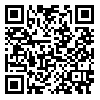دوره 9، شماره 2 - ( 2-1403 )
جلد 9 شماره 2 صفحات 382-372 |
برگشت به فهرست نسخه ها
چکیده: (614 مشاهده)
Background: Food insecurity is an important global challenge associated with various health problems such as diabetes. Diabetes mellitus is one of the most common metabolic diseases and is considered priority in Iran’s health system. The aim of this study is to evaluate the relationship between food insecurity and type 2 dibetes mellitus (T2DM) in Iran. Methods: The authors searched English databases including Scopus, Web of Science, PubMed, and Google Scholar and also Iranian databasesof SID and Magiran for the words food insecurity, Iran, and diabetes up to November 2021. Results: 8 articles, including 2853 participants, ranging from 148 to 440 were included in the meta-analysis. The pooled odds ratios (ORs) of the cross-sectional and case-control studies revealed that household food insecurity was significantly associated with the odds of diabetes (OR=2.04; 95% CI: 1.34- 3.09) and there was no evidence for publication bias (Egger’s test, P = 0.59); however, heterogeneity between studies (I2=85.9%) was observed. Similarly, according to subgroup analyses based on age, there was a significant association between household food insecurity and diabetes among the people under 50 years (OR= 2.9; 95% CI: 2.13-3.93; I2 = 56.4%, P=0.057), but not among people over 50 years (OR=1.32; 95% CI: 0.69-2.52; I2 = 78.3%, P=0.032) or between 30 and 65 years (OR=0.85; 95% CI: 0.49-1.48). Conclusion: This study shows that food insecurity affects the progression of type 2 DM. However, more longitudinal studies are needed for better identification of the link between food insecurity and T2DM.
دریافت: 1401/4/17 | انتشار: 1403/3/1 | انتشار الکترونیک: 1403/3/1
| بازنشر اطلاعات | |
 |
این مقاله تحت شرایط Creative Commons Attribution-NonCommercial 4.0 International License قابل بازنشر است. |

